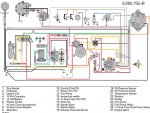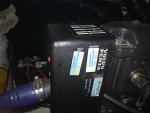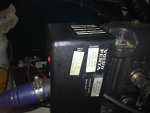RoyalFlush67
Cadet
- Joined
- Jun 16, 2020
- Messages
- 12
I have a no-click/no-start situation on my 99 Volvo Penta 5.0 GL. If I jump start red/yellow wire on starter solenoid to the positive battery post, boat starts great. I'm not getting any power to this wire when I crank the boat (0 volts). I've tested the start relay using Don S' HOW TO: Troubleshooting your engines starting system. Every test passed. Instead of using a test light, I used my voltmeter. Results are as follows:
1. 86 connection for relay to boat ground - 12 volts when cranking. 55 volts when not cranking. this is odd because on the next tests I got a full 12.7 volts, but not sure if this is normal.
2. 30 connection for relay to boat ground - 12.7 volts.
3. 30 and 85 connections for relay - 12.7 volts
4. tried jumping 30 to 87 at relay connections and boat did not start
5. Installed new relay with no luck
Thinking connection between relay and starter solenoid may be bad. Is it worth running a new wire from the relay to the starter solenoid? Not sure how wires hook into the relay connector though and need to verify in a wiring diagram that this is a straight connection (believe it is).
Here are some additional tests I've run and some other odd behavior:
1. Yellow/red at ignition key switch is only showing about 10 volts when trying to crank which is really odd. If I disconnect/pull the kill safety switch, voltage jumps back up to 12+ volts. replaced ignition key switch and this didn't change anything.
2. Tested for voltage drop between negative battery post and engine connection. drop was .4 volts. this seems high for a 2-3 foot 4-6 gauge wire but not sure how this could be causing a complete loss of voltage at the red/yellow wire on the starter solenoid. I would have already replaced this cable as a troubleshooting test, but it's going to be very difficult for me to disconnect the cable from the engine based on where it connects and a wire connector that is in the way of the nut that I will have to cut off.
Any thoughts would be appreciated. I'm close to bringing it to the mechanic I use for difficult repairs, but this is typically a 3 week wait in the middle of the summer.
1. 86 connection for relay to boat ground - 12 volts when cranking. 55 volts when not cranking. this is odd because on the next tests I got a full 12.7 volts, but not sure if this is normal.
2. 30 connection for relay to boat ground - 12.7 volts.
3. 30 and 85 connections for relay - 12.7 volts
4. tried jumping 30 to 87 at relay connections and boat did not start
5. Installed new relay with no luck
Thinking connection between relay and starter solenoid may be bad. Is it worth running a new wire from the relay to the starter solenoid? Not sure how wires hook into the relay connector though and need to verify in a wiring diagram that this is a straight connection (believe it is).
Here are some additional tests I've run and some other odd behavior:
1. Yellow/red at ignition key switch is only showing about 10 volts when trying to crank which is really odd. If I disconnect/pull the kill safety switch, voltage jumps back up to 12+ volts. replaced ignition key switch and this didn't change anything.
2. Tested for voltage drop between negative battery post and engine connection. drop was .4 volts. this seems high for a 2-3 foot 4-6 gauge wire but not sure how this could be causing a complete loss of voltage at the red/yellow wire on the starter solenoid. I would have already replaced this cable as a troubleshooting test, but it's going to be very difficult for me to disconnect the cable from the engine based on where it connects and a wire connector that is in the way of the nut that I will have to cut off.
Any thoughts would be appreciated. I'm close to bringing it to the mechanic I use for difficult repairs, but this is typically a 3 week wait in the middle of the summer.






















